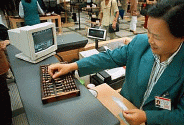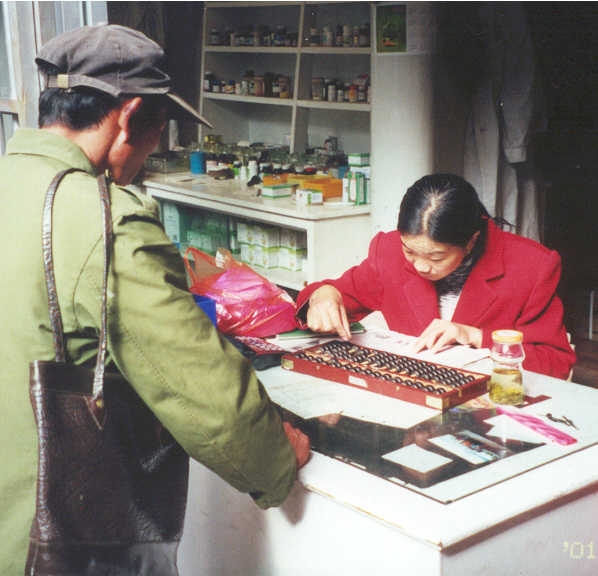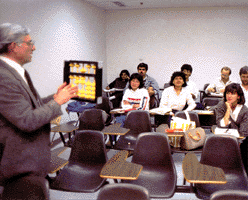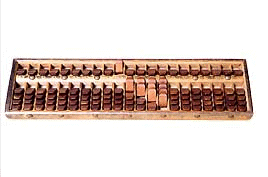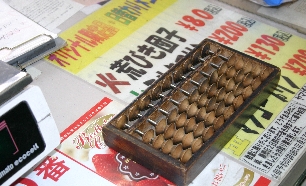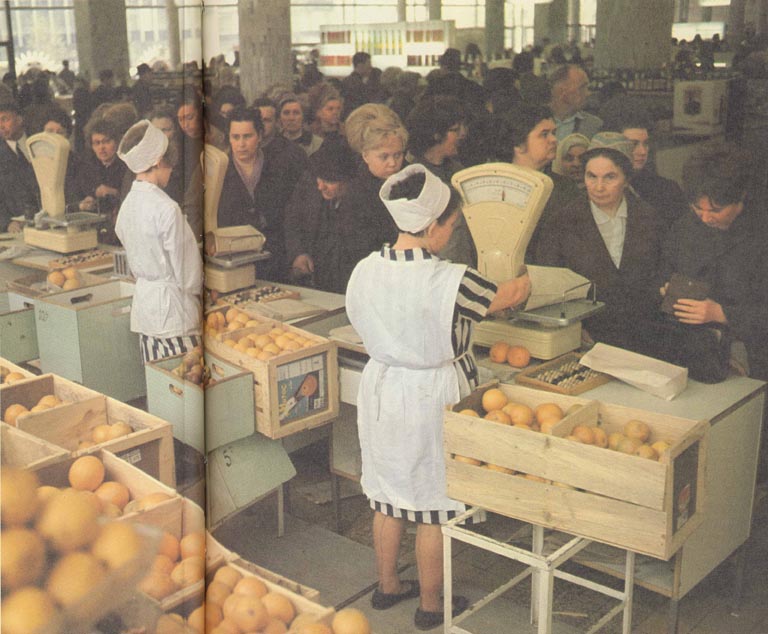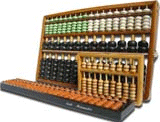
ABACUS JAVASCRIPT EMULATOR
ABACUS HYSTORY
Technology, like science, is motivated by the need to solve practical problems. The need to ease the burden of calculation was felt in the earliest societies. Technological solutions were developed soon after the invention of the place-value number system. The most successful of these solutions is the abacus, believed to have originated in Babylon around 3000 BC.
It is difficult to imagine counting without numbers, but there was a time when written numbers did not exist. The earliest counting device was the human hand and its fingers. Then, as larger quantities (larger than ten human-fingers could represent) were counted, various natural items like pebbles and twigs were used to help count. Merchants who traded goods not only needed a way to count goods they bought and sold, but also to calculate the cost of those goods. Until numbers were invented, counting devices were used to make everyday calculations. The abacus is one of many counting devices invented to help count large numbers.
In the history of mathematics, the contributions of the Roman Empire are sometimes overlooked.
It looks like the only contribution of Romans to math was killing Archimede.
Roman Numerals are considered cumbersome and the Roman's lack of contributions to mathematics, and the lack of the Zero, are held in low esteem.
And yet, the Roman Empire was likely the largest when viewed as a percent of world population. Their empire consistently built engineering marvels: roads that survive and are used to this day, homes and bath houses with indirect heating emulated today, plumbed sewer and water lines in and out of homes and public buildings, indoor toilets, aquaducts that included long tunnels and bridges, and huge, beautiful buildings. Their engineers and architects designed and built these using counting boards and hand abaci; using Roman Numerals only to record the results.
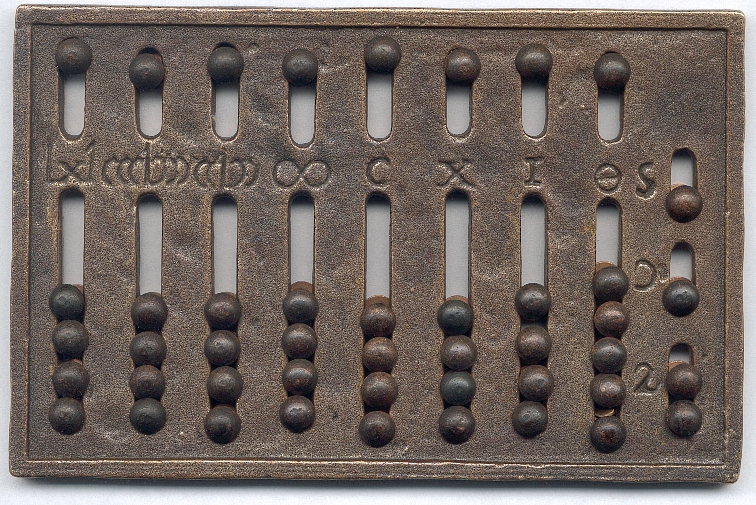
Roman Hand-Abacus(Photo from Museo Nazionale Ramano at Piazzi delle Terme, Rome.
The longevity of Roman empire was due to their commercial trade-- they were businessmen. The intricate, complex, and extensive accounting of their trade was conducted with counting boards and hand-abaci; again using Roman Numerals only to record the results.
And as anyone knows who has used a counting board or abacus, your rows or columns often represent nothing, or zero. Since the Romans used Roman Numerals to record results, and since Roman Numerals were positively definitive, there was no need for a zero notation. But the Romans certainly knew the concept of zero occuring in any place value, row or column.
One could also infer that they were aware of the concept of a negative number. How else would Roman merchants understand and manipulate liabilities against assets and loans versus investments?
The Romans developed their hand-abacus as a portable counting board-- the first portable calculating device for both engineers and businessmen.
The abacus was made of a metal plate where the beads ran in slots. The size was such that the abacus could fit in a modern shirt pocket. The upper slots contained a single bead while the lower slots contained 4 beads, the only exceptions being the two right-most columns, marked θ and S.
Note the longer slots below the θ and S positions, the 5 beads in the lower slot of the θ position, the 2 beads in the lower slot of the S position, and the absence of an upper slot in the S position. I wonder what the ')' and '2' symbols along the right side of the S slot meant?
Obviously the units in the θ position were 1/12 of the I position, and the units in the S position were 1/3 of the θ position. So the upside down reversed 3 character seems appropriate to represent 1/3; or, more likely, our symbol for 3 came from the Roman symbol for 1/3.
It is also worth noting that:
- the Roman hand-abacus predates the Chinese "invention" of the Suan Pan;
- the Romans traded with the Chinese over the Silk Road (did the Chinese copy the Romans' hand-abacus?);
- the Roman hand-abacus has the refinements attributed to the modern Japanese Soroban; i.e. one bead above and four beads below the bar (did the Japanese copy the Romans' hand-abacus instead of the Chinese Suan Pan?);
- the Roman hand-abacus incorporates mixed base arithmetic (in the two rightmost columns), another original enhancement by the Romans that is not present in any other abacus.
It is important to distinguish the early abacuses (or abaci) known as counting boards from the modern abaci. The counting board is a piece of wood, stone or metal with carved grooves or painted lines between which beads, pebbles or metal discs were moved. The abacus is a device, usually of wood (plastic, in recent times), having a frame that holds rods with freely-sliding beads mounted on them.
The modern form of the abacus, which uses beads strung on a wire, was invented in Egypt around 500 BC. China and Japan used a computing tray from about 200 AD. In medieval Europe Gerbert of Aurillac used the abacus in the form of a calculating board.
The use of the abacus or checker board for administrative purposes continued in Europe until 1791, when the French National Assembly, which was set up through the French Revolution two years earlier, adopted the Indian calculation method for France and banned the use of the abacus from schools and government offices.
This woodcut from the Margarita Philosophica of Gregorius Reisch, published in Freiburg in 1503, shows "Arithmetica" watching a competition between an "abacist" and an "algorist". Judging from the clothes of the two competitors, the abacist is a monk and the algorist a worldly scholar.
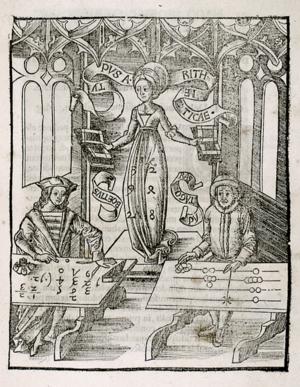
Arithmetica appears to favour the algorist; her own clothes are covered in Indian numerals, and she looks approvingly at the algorist's progress.
Image: Museum of the History of Science, Oxford; public domain
The abacus as we know it today, appeared (was chronicled) circa 1200 A.D. in China; in Chinese, it is called suan-pan. On each rod, this classic Chinese abacus has 2 beads on the upper deck and 5 on the lower deck; such an abacus is also referred to as a 2/5 abacus. You can calculate from 1 to 15 in a unit with 2/5 style abacus. This was very useful for chinese because 1kin(a unit of weight in China) was 16ryo.
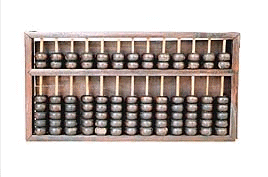
Abacus Parts: The various parts of the abacus are identified here: the frame, the beam, the beads and rods and the upper and lower decks.
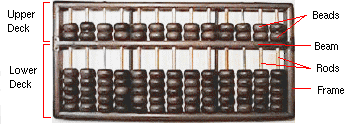
Circa 1600 A.D., use and evolution of the Chinese 1/5 abacus was begun by the Japanese via Korea. In Japanese, the abacus is called soroban. The 1/4 abacus, a style preferred and still manufactured in Japan today, appeared circa 1930. The 1/5 models are rare today and 2/5 models are rare outside of China (excepting Chinese communities in North America and elsewhere).
The 2/5 style survived unchanged until about 1850 at which time the 1/5 (one bead on the top deck and five beads on the bottom deck) abacus appeared.
ABACUS USAGE
Basics
The abacus is prepared for use by placing it flat on a table or one's lap and pushing all the beads on both the upper and lower decks away from the beam. The beads are manipulated with either the index finger or the thumb of one hand.
Bead Values
Each bead in the upper deck has a value of 5; each bead in the lower deck has a value of 1. Beads are considered counted, when moved towards the beam that separates the two decks.
Counting
After 5 beads are counted in the lower deck, the result is "carried" to the upper deck; after both beads in the upper deck are counted, the result (10) is then carried to the left-most adjacent column.
The right-most column is the ones column; the next adjacent to the left is the tens column; the next adjacent to the left is the hundreds column, and so on. Floating point calculations are performed by designating a space between 2 columns as the decimal-point and all the rows to the right of that space represent fractional portions while all the rows to the left represent whole number digits.
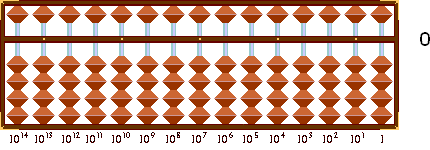
PHOTO GALERY
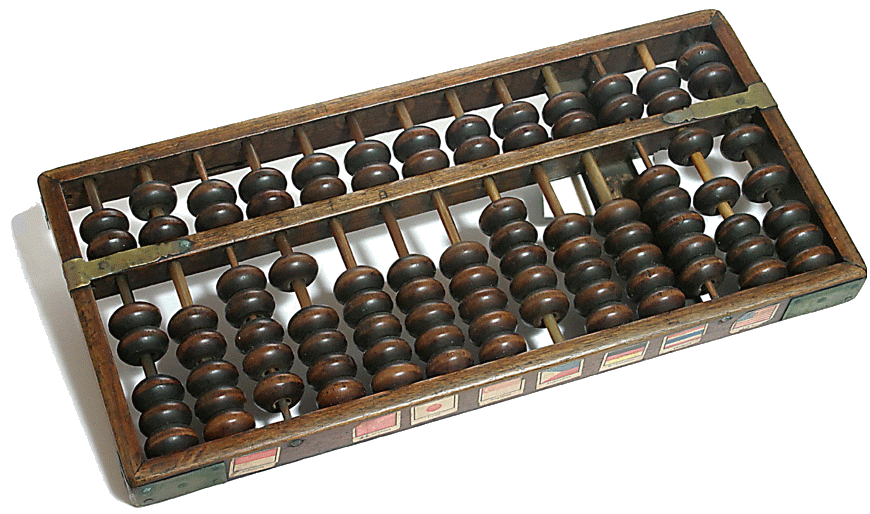
Chinese soan-pan: Construction is a typical 13 rod frame with 2 beads above the beam and 5 beads below. It's 15 inches long by 7 inches (~18 cm)wide and weighs just over 1 kilogram.

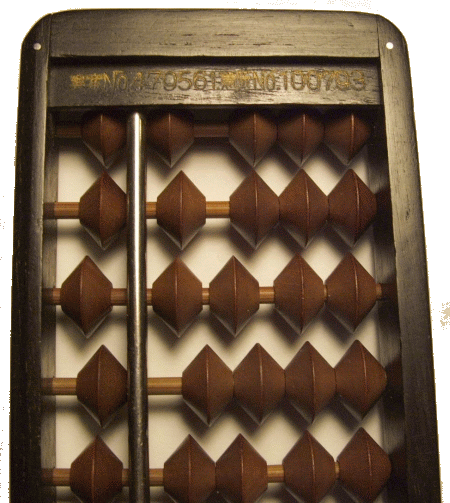
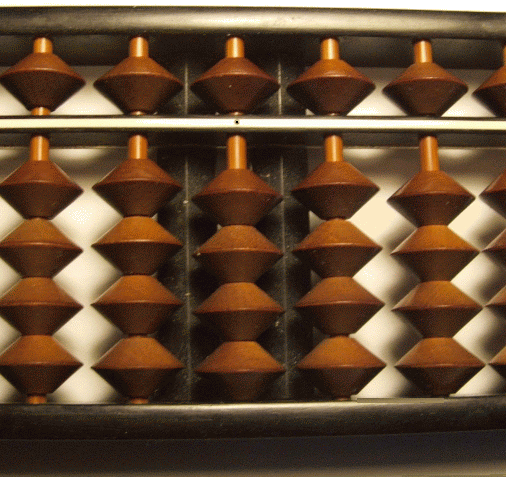
Japanese sorobanThis one is a very typical 1:4 bead, 27 rod soroban circa 1960. The frame looks to be ebony. This is a real workhorse and one of my favorites. It measures 15 inches (~38 cm)long by 2.5 inches (~6.5 cm)wide and the beads are about 1.25 cm across.
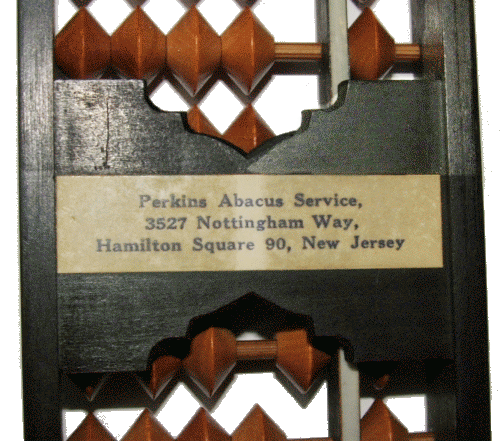
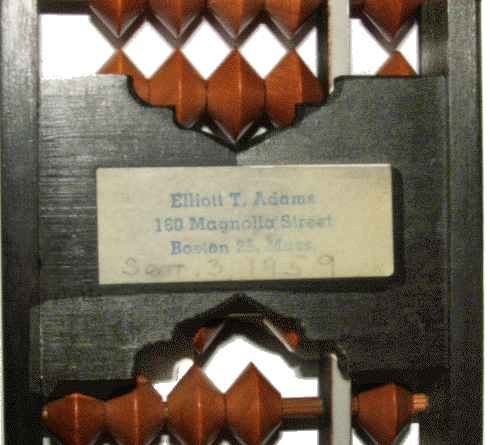

This is another 1/4 style soroban. The centre unit marker has three dots grouped together - red in the middle flanked by black on either side. The soroban came with a flyer (120kb pdf file) for a company called 'Perkins Abacus Service'. On the supporting slats at the back of the soroban there are two stickers; one for for the Perkins Company and another that's quite faded but still readable. It's the name and address of a previous owner. If you look closely you can see it's dated Sept.3, 1959. The soroban has reinforced metal ends and measures 15 inches x 2.5 inches.
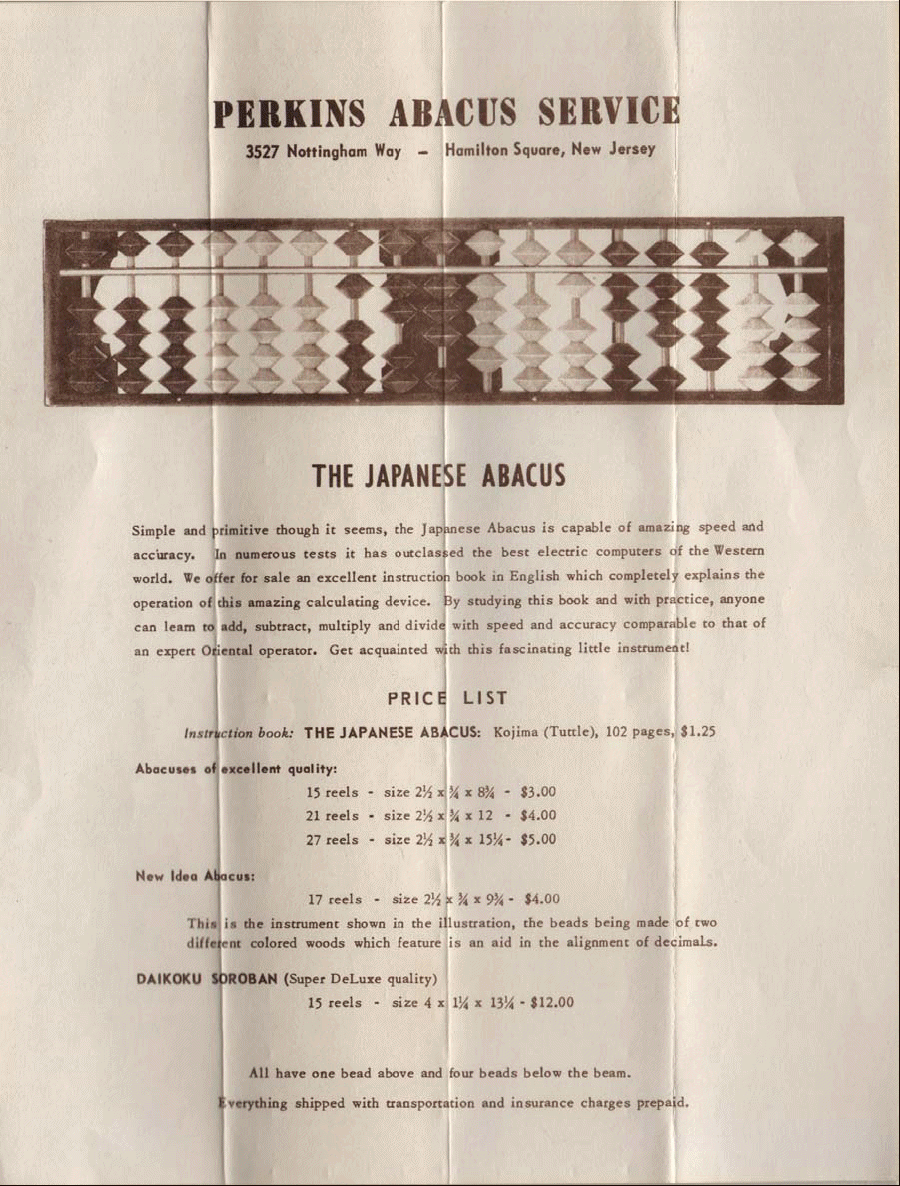
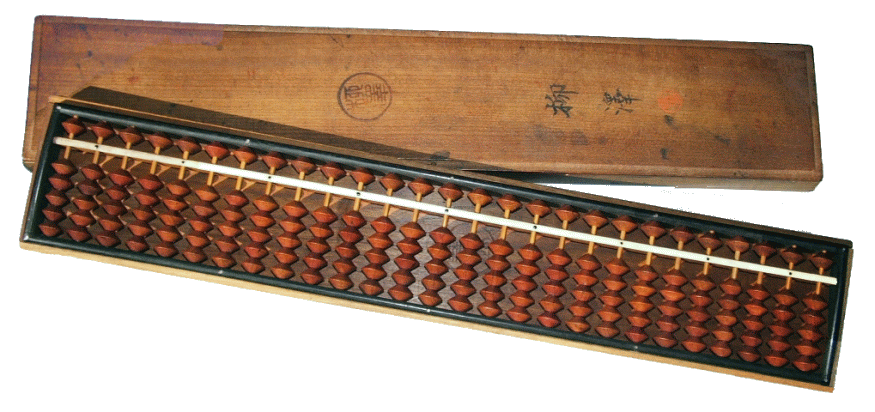
A 1/5 style soroban.With its ebony frame, bone reckoning bar and black inlay unit markers this soroban is very butiful. The Kanji on the box reads Yanagisawa which means "Willow on the Marsh". It may be possible the name of the original owner. The box has been branded with the same name. (Circle brand visible in the middle of the box.) The box is made of cedar and has kept the soroban in perfect condition for nearly 100 years. The soroban has 27 rods with 1 bead above the beam and 5 beads below. It's 15.5 inches long by 3 inches wide.
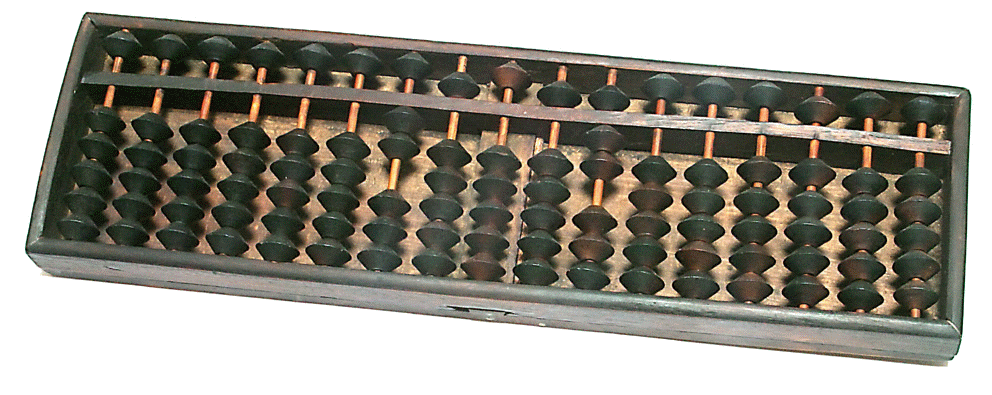
A 1/5 style "merchant" soroban, so called because it is quite a bit larger than the two soroban above. The bead configuration is the older 1/5 style. It measures 15.5 inches by 4.5 inches. The age is unknown.
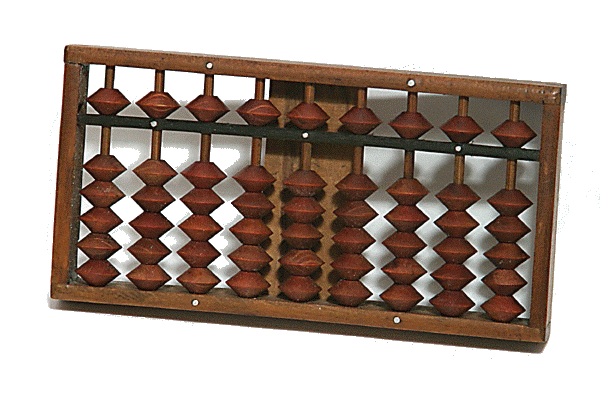
The beautifully made, tiny soroban in the picture above presumably pre-dates the 1930's because it too has been made in the 1/5 bead style. It's only 4.25 inches long by 2.25 inches wide.
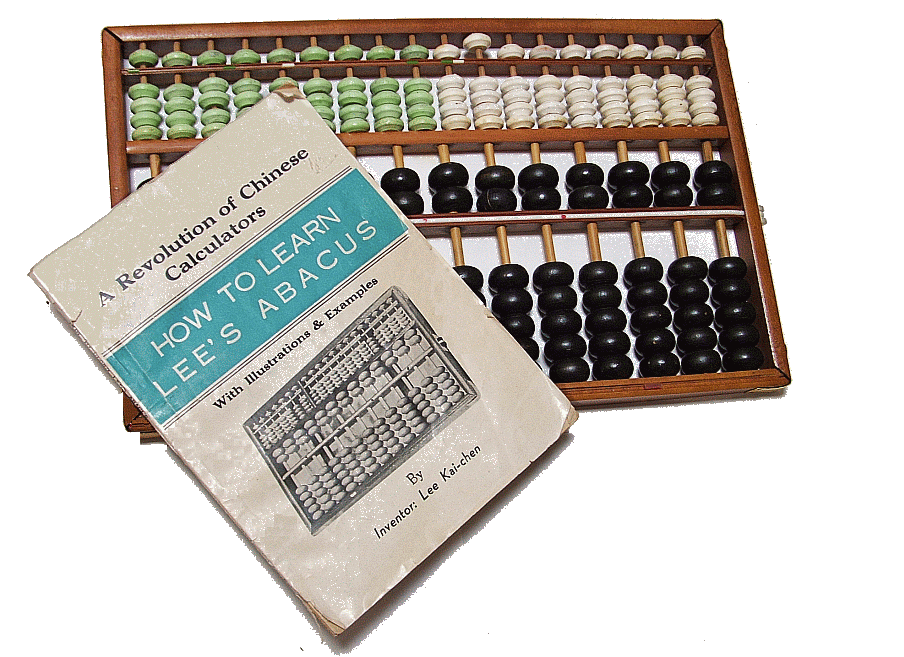
The Lee Kai-chen Abacus was developed and manufactured in Taiwan, China. Few of these remarkable instruments remain as production only lasted a few years. On the beam of the suan pan in the lower part of the frame there is an adjustable 'place setting vernier'. With a moveable indicator that runs along the bottom rail and adjustable unit rod markers on the beam of the soroban above Lee called his abacus, "A Revolution of Chinese Calculators." This abacus was made circa 1959 and comes with a 58 page instruction manual.
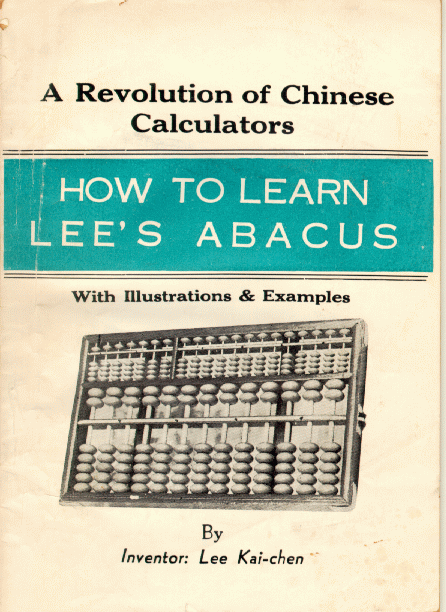
Next image is a photo of a Russian abacus named schoty (счëты)
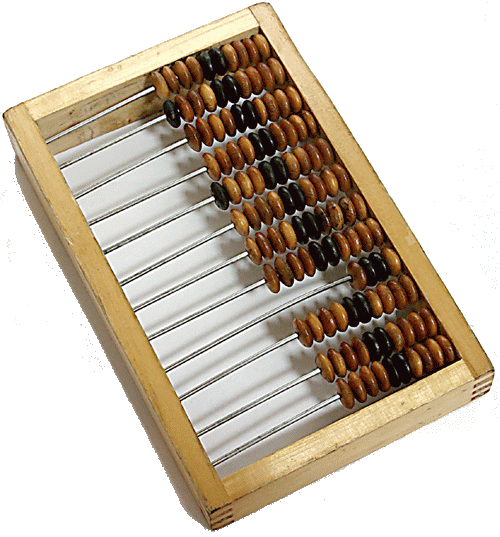
This schoty measures 8.5 inches long by 5.5 inches wide.
The frame is made of birch and has been put together using tongue and groove
construction methods. The beads are made of polished wood
and the fifth and sixth bead in each row is painted black for an easy visual
reference. This particular
abacus dates to around 1970 and is typical of the style. Notice the fourth row
from the bottom; it only has four beads.
This allows for calculations of ¼ ruble.
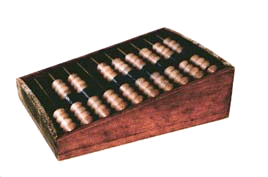
Older models as the one in the
picture above have a second row of four
beads at the very bottom of
the frame allowing for calculations of ¼ kopika. Simple calculations involving
addition and subtraction are easily done.
Note that both the abacus and the counting board are mechanical aids used for counting; they are not calculators in the sense we use the word today. The person operating the abacus performs calculations in their head and uses the abacus as a physical aid to keep track of the sums, the carrys, etc.
Abacus use requires some training, but once it is mastered it allows extremely fast and accurate calculations.

Finger Technique: A Japanese textbook published in 1954 shows the proper technique for moving the beads. It shows the thumb being used to count beads in the lower deck and the index finger being used in all other cases.
Proper finger technique is paramount in achieving proficiency on the abacus. With a Chinese abacus, the thumb and the index finger together with the middle finger are used to manipulate the beads. Beads in lower deck are moved up with the thumb and down with the index finger. In certain calculations, the middle finger is used to move beads in the upper deck.
With the Japanese version, only the index finger and thumb are used. The beads are moved up with the thumb and down with the index finger. However, certain complex operations require that the index finger move beads up; e.g. adding 3 to 8 (the adding of the three is called Jian Chi Jia Shi which literally means, "subtract 7 add 10").
ABACUS TODAY
An exciting contest between the Japanese abacus, (handled by the "champion operator of the abacus" of the Japanese postal service)and the electric calculating machine (operated by "the most expert operator of the electric calculator" of the United States army) was held in Tokyo on November 12, 1946, under the sponsorship of the U. S. Army newspaper, the Stars and Stripes.
The contest ended 4:1 for the abacus. In reporting the contest, the Stars
and Stripes remarked:
"The machine age tool took a step backward yesterday at the Emie Pyle Theater as the abacus, centuries old, dealt defeat to the most up-to-date electric machine now being used by the United States Government...The abacus victory was decisive."
The Nippon Times reported the contest as follows:
"Civilization, on the threshold of the atomic age, tottered Monday afternoon as the 2,000-year-old abacus beat the electric calculating machine in adding, subtracting, dividing and a problem including all three with multiplication thrown in, according to UP. Only in multiplication alone did the machine triumph..."
The American representative of the calculating machine was Pvt. Thomas Nathan Wood of the 20th Finance Disbursing Section of General MacArthur's headquarters, who had been selected in an arithmetic contest as the most expert operator of the electric calculator in Japan. The Japanese representative was Mr. Kiyoshi Matsuzaki, a champion operator of the abacus in the Savings Bureau of the Ministry of Postal Administration.
As may be seen from the results tabulated on the following page [sic], the abacus scored a total of 4 points as against 1 point for the electric calculator. Such results should convince even the most skeptical that, at least so far as addition and subtraction are concerned, the abacus possesses an indisputable advantage over the calculating machine. Its advantages in the fields of multiplication and division, however, were not so decisively demonstrated.
| Type of Problem | Name | 1st Heat | 2nd Heat | 3rd Heat | Score |
|---|---|---|---|---|---|
| Addition: 50 numbers each containing 3 to 6 digits | Matsuzaki | 1m. 14.9s (Victor) |
1m 16s (Victor) |
1 | |
| Wood | 2m 0.2s (Defeated) |
1m 58s (Defeated) |
|||
| Subtraction: 5 problems with minuends and subtrahends of from 6 to 8 digits each | Matsuzaki | 1m .4s All correct (Victor) |
1m .8s 4 correct (No decision) |
1m All correct (Victor) |
1 |
| Wood | 1m 30s All correct (Defeated) |
1m 35s 4 correct (No decision) |
1m 22s 4 correct (Defeated) |
||
| Multiplication: 5 problems each containing 5 to 12 digits in the multiplier and multiplicand | Matsuzaki | 1m 44.6s 4 correct (Defeated) |
1m 19s All correct (Victor) |
2m 14.4s 3 correct (Defeated) |
|
| Wood | 2m 22s 4 correct (Defeated) |
1m 20s All correct (Defeated) |
1m 53.6s 4 correct (Victor) |
1 | |
| Division: 5 problems each containing 5 to 12 digits in the divisor and dividend | Matsuzaki | 1m 36.6s All correct (Victor) |
1m 23s 4 correct (Defeated) |
1m 21s All correct (Victor) |
1 |
| Wood | 1m 48s All correct (Defeated) |
1m 19s All correct (Victor) |
1m 25s 4 correct (Defeated) |
||
| Composite problems: 1 problem in addition 30 6-digit numbers; 3 problems in subtraction, each with two 6-digit numbers; 8 problems in multiplication each with two figures containing a total of 5 to 12 digits; 3 problems in division, each with two figures containing a total of 5 to 12 digits | Matsuzaki | 1m 21s All correct (Victor) |
1 | ||
| Wood | 1m 26s 4 correct (Defeated) |
||||
| Total Score: | Matsuzaki | 4 | |||
| Wood | 1 |
The abacus, or soroban as it is called in Japan, is one of the first objects that strongly attracts the attention of the foreigner in Japan. When he buys a few trifling articles at some store, he soon notices that the tradesman does not perplex himself with mental arithmetic, but instead seizes his soroban, prepare it by a tilt and a rattling sweep of his hand, and after a deft manipulation of rapid clicks, reads off the price. It is true that the Japanese tradesman often uses his board and beads even when the problem is simple enough to be done in one's head, but this is only because the use of the abacus has become a habit with him. If he tried, he could no doubt easily add 37 and 48 in his head. But such is the force of habit that he does not try to recognize the simplicity of any problem; instead, following the line of least resistance, he adjusts his soroban for manipulation, and begins clicking the beads, thus escaping any need of mental effort.
Doubtlessly the Westerner, with his belief in the powers of mental arithmetic and the modern calculating machine, often mistrusts the efficiency of such a primitive looking instrument.
However, his mistrust of the soroban is likely to be transformed into admiration when he gains some knowledge concerning it.
For the soroban, which can perform in a fraction of time, a difficult arithmetic calculation that the Westerner could do laboriously only by means of pencil and paper, possesses distinct advantages over mental and written arithmetic.
The Japanese tradesman with his soroban would easily outstrip a rapid and accurate Western accountant even with his adding machine.
